
The conservation and restoration of cultural property focuses on protection and care of cultural property, including artworks, architecture, archaeology, and museum collections. Conservation activities include preventive conservation, examination, documentation, research, treatment, and education. This field is closely allied with conservation science, curators and registrars.

A museum is a building or institution that cares for and displays a collection of artifacts and other objects of artistic, cultural, historical, or scientific importance. Many public museums make these items available for public viewing through exhibits that may be permanent or temporary. The largest museums are located in major cities throughout the world, while thousands of local museums exist in smaller cities, towns, and rural areas. Museums have varying aims, ranging from the conservation and documentation of their collection, serving researchers and specialists to catering to the general public. The goal of serving researchers is not only scientific, but intended to serve the general public.
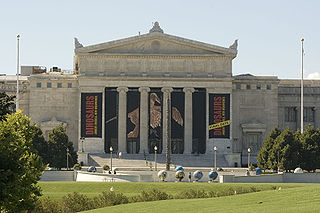
The Field Museum of Natural History (FMNH), also known as The Field Museum, is a natural history museum in Chicago, Illinois, and is one of the largest such museums in the world. The museum is a popular natural-history museum for the size and quality of its educational and scientific programs, as well as due to its extensive scientific-specimen and artifact collections. The permanent exhibitions, which attract up to two million visitors annually, include fossils, current cultures from around the world, and interactive programming demonstrating today's urgent conservation needs. The museum is named in honor of its first major benefactor, the department-store magnate Marshall Field. The museum and its collections originated from the 1893 World’s Columbian Exposition and the artifacts displayed at the fair.
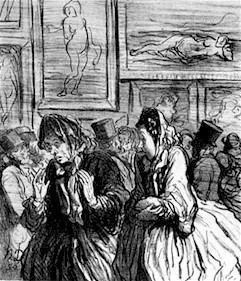
An art exhibition is traditionally the space in which art objects meet an audience. The exhibit is universally understood to be for some temporary period unless, as is rarely true, it is stated to be a "permanent exhibition". In American English, they may be called "exhibit", "exposition" or "show". In UK English, they are always called "exhibitions" or "shows", and an individual item in the show is an "exhibit".
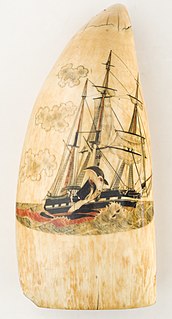
Scrimshaw is scrollwork, engravings, and carvings done in bone or ivory. Typically it refers to the artwork created by whalers, engraved on the byproducts of whales, such as bones or cartilage. It is most commonly made out of the bones and teeth of sperm whales, the baleen of other whales, and the tusks of walruses. It takes the form of elaborate engravings in the form of pictures and lettering on the surface of the bone or tooth, with the engraving highlighted using a pigment, or, less often, small sculptures made from the same material. However, the latter really fall into the categories of ivory carving, for all carved teeth and tusks, or bone carving. The making of scrimshaw probably began on whaling ships in the late 18th century and survived until the ban on commercial whaling. The practice survives as a hobby and as a trade for commercial artisans. A maker of scrimshaw is known as a scrimshander. The word first appeared in the logbook of the brig By Chance in 1826, but the etymology is uncertain.

Folk art covers all forms of visual art made in the context of folk culture. Definitions vary, but generally the objects have practical utility of some kind, rather than being exclusively decorative. The makers of folk art are typically trained within a popular tradition, rather than in the fine art tradition of the culture. There is often overlap, or contested ground with 'naive art'. "Folk art" is not used in regard to traditional societies where ethnographic art continue to be made.

A museum is distinguished by a collection of often unique objects that forms the core of its activities for exhibitions, education, research, etc. This differentiates it from an archive or library, where the contents may be more paper-based, replaceable and less exhibition oriented, or a private collection of art formed by an individual, family or institution that may grant no public access. A museum normally has a collecting policy for new acquisitions, so only objects in certain categories and of a certain quality are accepted into the collection. The process by which an object is formally included in the collection is called accessioning and each object is given a unique accession number.
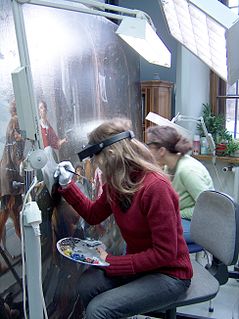
A conservator-restorer is a professional responsible for the preservation of artistic and cultural artifacts, also known as cultural heritage. Conservators possess the expertise to preserve cultural heritage in a way that retains the integrity of the object, building or site, including its historical significance, context and aesthetic or visual aspects. This kind of preservation is done by analyzing and assessing the condition of cultural property, understanding processes and evidence of deterioration, planning collections care or site management strategies that prevent damage, carrying out conservation treatments, and conducting research. A conservator's job is to ensure that the objects in a museum's collection are kept in the best possible condition, as well as to serve the museum's mission to bring art before the public.

An exhibition, in the most general sense, is an organized presentation and display of a selection of items. In practice, exhibitions usually occur within a cultural or educational setting such as a museum, art gallery, park, library, exhibition hall, or World's fairs. Exhibitions can include many things such as art in both major museums and smaller galleries, interpretive exhibitions, natural history museums and history museums, and also varieties such as more commercially focused exhibitions and trade fairs.
Conservation and restoration of movable cultural property is a term used to denote the conservation of movable cultural property items in libraries, archives, museums and private collections. Conservation encompasses all the actions taken toward the long-term preservation of cultural heritage. Activities include examination, documentation, treatment, and preventive care, which is supported by research and education. Object conservation is specifically the actions taken to preserve and restore cultural objects. The objects span a wide range of materials from a variety of cultures, time periods, and functions. Object conservation can be applied to both art objects and artifacts. Conservation practice aims to prevent damage from occurring. This is called ‘preventive conservation’. The purpose of preventive conservation is to maintain, and where possible enhance, the condition of an object, as well as managing deterioration risks, such as handling and environmental conditions. Historically, object conservation was focused on the category of fine arts but now many different types of objects are conserved. Each type of object material, typically denoted by organic or inorganic then the specific medium, requires a specialized professional conservator and often requires collaborative work between museum staff, scientists, and conservators.
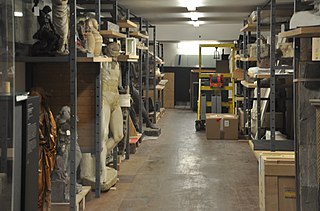
A collection manager ensures the proper care and preservation of objects within cultural institutions such as museums, libraries, and archives. Collection managers, along with registrars, curators, and conservators, play an important role in collections care. Collection Managers and Registrars are two distinct collection roles that are often combined into one within small to mid-size cultural institutions. Collection Managers can be found in large museums and those with a history and natural history focus whose diverse collections require experienced assessment to properly sort, catalog, and store artifacts. A collection manager may oversee the registrar, archivist, curator, photographer, or other collection professionals, and may assume the responsibilities of these roles in their absence within an organization.
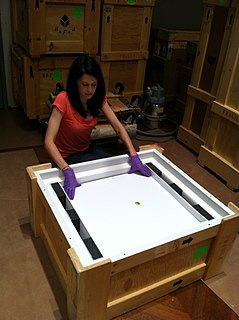
An art handler, also sometimes called an art preparator, is a trained individual who works directly with objects in museums, art galleries and various other venues including private collectors, corporate art collections, public art collections and various other institutions. Art handlers work in coordination with registrars, collection managers, conservator-restorers, exhibition designers, and curators, among others, to ensure that objects are safely handled and cared for. Often they are responsible for packing and unpacking art, installing and deinstalling art in exhibitions, and moving art around the museum and storage spaces. They are an integral part of a museum and collections care.

Collections management involves the development, storage, and preservation of cultural property, as well as objects of contemporary culture in museums, libraries, archives and private collections. The primary goal of collections management is to meet the needs of the individual collector or collecting institution's mission statement, while also ensuring the long-term safety and sustainability of the cultural objects within the collector's care. Collections management, which consists primarily of the administrative responsibilities associated with collection development, is closely related to collections care, which is the physical preservation of cultural heritage. The professions most influenced by collections management include collection managers, registrars, and archivists.

A Conservation Technician is a specialist who is trained in basic conservation methods pertaining to cultural property and may work in museums or public or private conservation organizations. Typically an individual may work with or be subordinate to a conservator. A technician may also work in conjunction with other collection staff, such as a registrar (museum) or collection manager.

A museum/library/archival registrar is responsible for implementing policies and procedures that relate to caring for collections of cultural institutions like archives, libraries, and museums. These policies are found in the museum's collections policy, the guiding tenet of the museum explaining why the institution is in operation, dictating the museum's professional standards regarding the objects left in its care. Registrars focus on sections that include acquisitions, loans, exhibitions, deaccessions, storage, packing and shipping, security of objects in transit, insurance policies, and risk management.

A conservation scientist is a museum professional who works in the field of conservation science and whose focus is on the research of cultural heritage through scientific inquiry. Conservation scientists conduct applied scientific research and techniques to determine the material, chemical, and technical aspects of cultural heritage. The technical information conservation scientists gather is then used by conservator and curators to decide the most suitable conservation treatments for the examined object and/or adds to our knowledge about the object by providing answers about the material composition, fabrication, authenticity, and previous restoration treatments.

A textile conservator is a conservator-restorer charged with the care, treatment, research, and preservation of textiles. Issues addressed by a textile conservator are generally related to the field of textile preservation, and include damage caused to textiles by: light, mold and mildew, insects, cleaning, surface cleaning, washing, mounting for display, and storage. Variations in textile types and “the diversity of the textile conservator’s work makes it a very rewarding profession”. Textiles are among the most fragile artifacts, as they are susceptible to damage from atmospheric pollutants, moisture, biological organisms, and environmental changes and care varies with size, shape, material, and condition issues, all of which a textile conservator must be well versed.

The conservation and restoration of neon objects is the process of caring for and maintaining neon objects (artworks), and includes documentation, examination, research, and treatment to ensure their long-term viability, when desired.

The exhibition of cultural property is a practice used by organizations where collected objects are put on display to the public. The objects are carefully chosen and placed together to offer educational value, and often to tell a story.
The conservation and restoration of ancient Greek pottery is a sub-section of the broader topic of conservation and restoration of ceramic objects. Ancient Greek pottery is one of the most commonly found types of artifacts from the ancient Greek world. The information learned from vase paintings forms the foundation of modern knowledge of ancient Greek art and culture. Most ancient Greek pottery is terracotta, a type of earthenware ceramic, dating from the 11th century BCE through the 1st century CE. The objects are usually excavated from archaeological sites in broken pieces, or shards, and then reassembled. Some have been discovered intact in tombs. Professional conservator-restorers, often in collaboration with curators and conservation scientists, undertake the conservation-restoration of ancient Greek pottery.




















